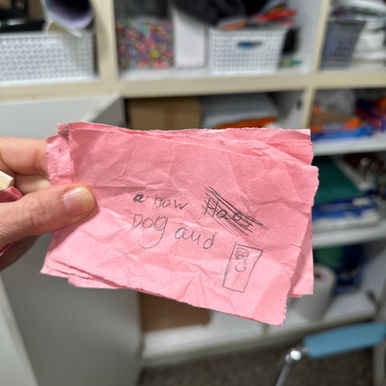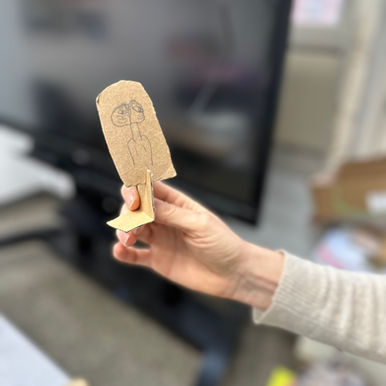
5/29/24
Classroom Visits
In the Classroom with Maria D. Rapicavoli
CMA Resident Artist Maria D. Rapicavoli shares how she relates to her students through her immigrant background.
Click to expand media gallery.
As part of CMA's Residency for Experimental Arts Education, Maria D. Rapicavoli teaches art to second-through-fifth graders twice weekly at Hudson Guild, one of the oldest community centers in Manhattan's Chelsea neighborhood. Below, visit Maria in her classroom and get a glimpse at her students' artworks.

On Windows and Domestic Architecture.
My students are very focused on houses and domesticity. When I first introduced the window project, they immediately honed in on the architecture of the home. My students live in the Elliott Houses surrounding Hudson Guild, so they all live in small apartments. That’s why they love to represent freestanding houses.
This student made a house with a big garden. For her, the project was all about the outdoor space that she doesn’t have.

For them, the idea of large windows means a beautiful house. When we were walking to the Whitney Museum, I pointed out the new condos with fully mirrored exteriors. I said, “This is not private. Everyone can see you! Would you really like to live there?” They were like, “Yeah of course! Look how big the windows are.”
Even before we began discussing the window project, architecture played a big role in a lot of students’ projects. There was one class where I asked students what they wanted to make, and they immediately responded “a house.” They didn’t give it a second thought!

On Abstraction and Representation.
We did this face project last week. We were talking about perspective and points of convergence, so I showed them examples of multi-faced sculptures and cubism. We looked at images of Bust of Sylvette, the statue near Washington Square Park. They were confused by it at first, but then they started to create some really amazing works.

Isabelle and Abby are twins, and they made this work together. It’s functional, like a bracelet. Isn’t it wonderful? It’s also a double face.

This work is an attempt to move away from representation. First the student made a face, but then she covered it with color. She wasn't happy with a realistic representation, so I reminded her that cubism was not about being realistic, but about different points converging.

Mason was not really into building a face sculpture, but he was very excited about making a multi-faceted space. This is a guy with a phone, and these are all his friends. Mason includes many different characters in his work and always makes drawings of them.

This is a project that Shannon has been working on for a while. It was part of the papier-mâché project, but she wanted to make something very ambitious. It’s a large dress, and we’re going to put a mannequin body on top.

These slips are from the project where students identified something that they want to bring into their lives. Look how detailed this one is. It’s an iPhone 14, which you can tell because it has three lenses!

On Brothers and Sisters.
There are always two or three students who will stay for the second class. I let them work independently and keep the cabinet door open so they can choose their art materials.

There is a brother and sister that I hope will go on to become artists. They are very, very talented. The sister is constantly asking questions and is very critical and curious about art. She will ask me “do you call it art?” Meanwhile, the brother is always trying to build things. He keeps asking me for solutions to make his sculptures work. I have been buying different materials and tape because he’s been so curious.
On Age Differences and Creativity.
I have found that my students respond best when I give them a specific thing to make. The telescope project was an example of one of those projects — students had a very clear idea of what they wanted to make.

I also notice a major difference between the 2nd–3rd graders and the 4th–5th graders. The 2nd–3rd graders are very open with their creativity. They also influence each other a lot. If one student is using purple, they will all use purple. The 4th–5th graders are more reluctant to use their creativity. They naturally gravitate towards representation, but I have been introducing them to abstract art all year long. They were very skeptical about abstraction at the beginning of the year, but now they are really into it.

My teaching experience is mostly with kids that are either younger or older than my current students. It’s interesting to see how my students experience art. They are more self-conscious than toddlers or younger kids. At the same time, they’re still kids, so they like to play and have fun. Of course, they want to look cool, and don’t always want to show their friends that they actually like making art!
On Exploring the Chelsea Neighborhood.
The field trips to galleries and museums have been an incredible experience, not just for my students, but also for me. I’m used to teaching kids who have been exposed to art. However, my students at Hudson Guild had no idea what a museum or gallery was. They had never been to the High Line, even though it’s minutes away from where they live. Now that they’ve had these experiences with art, they can go back for free, whenever they want. I think it’s amazing. It has made my whole experience as an Artist in Residence.

They are also starting to see art wherever they go. When we are walking to a museum or gallery, they’ll point to something on the High Line and ask “Ms. Maria, is that art?” They are seeing and understanding that art is not just about decoration. It’s not just paintings that you make in art class. It’s something you can experience outside, and it’s all around them.
On Relating to Her Students.
I learn from my students every day, because they challenge me on many levels. English is not my first language, and they use a lot of slang that I don’t understand. Our communication is often built on misunderstandings. Also, as a foreigner, my students don’t always know how to relate to me. When we first met, they knew there was a cultural difference between us, even though I have been in the United States for a long time.

Many of my students are minorities, and they don’t realize that I am also part of a minority in my own country. I’m Sicilian, so I have experienced racism my entire life, which can be hard for Americans to understand because it’s not based on skin color. They have very derogatory names for people from the South of Italy, and I have been called those words many times by people from my own country. However, in America, I am very privileged because of the color of my skin. My students are starting to understand that with me. They recognize that I’m different from them, yet there is something connecting us.

My students are not very familiar with Italy or Italian culture. They do love hearing stories about Mount Etna, the volcano that I grew up next to. I’m from Catania, Sicily — an area surrounded by beautiful nature. New York City is quite the opposite in terms of setting, but being in a big city has a lot of advantages that I didn’t have growing up. I tell my students that I grew up in a small town that was full of nature, but had zero art. In contrast, they have the opportunity to see amazing art, right here in their neighborhood. It’s very special for them. I hope they will start walking towards the galleries on 10th Avenue and keep exploring their neighborhood.




















































